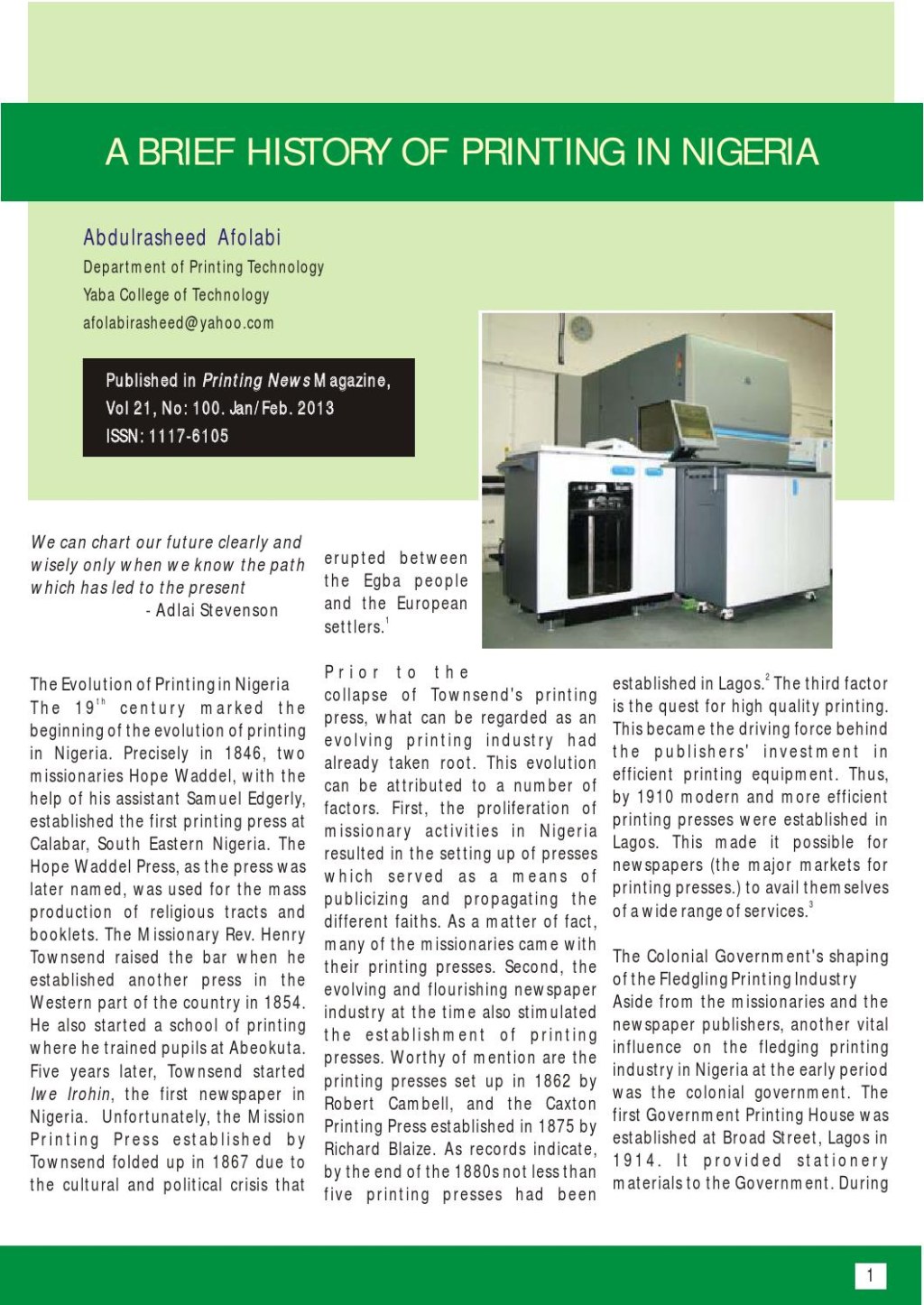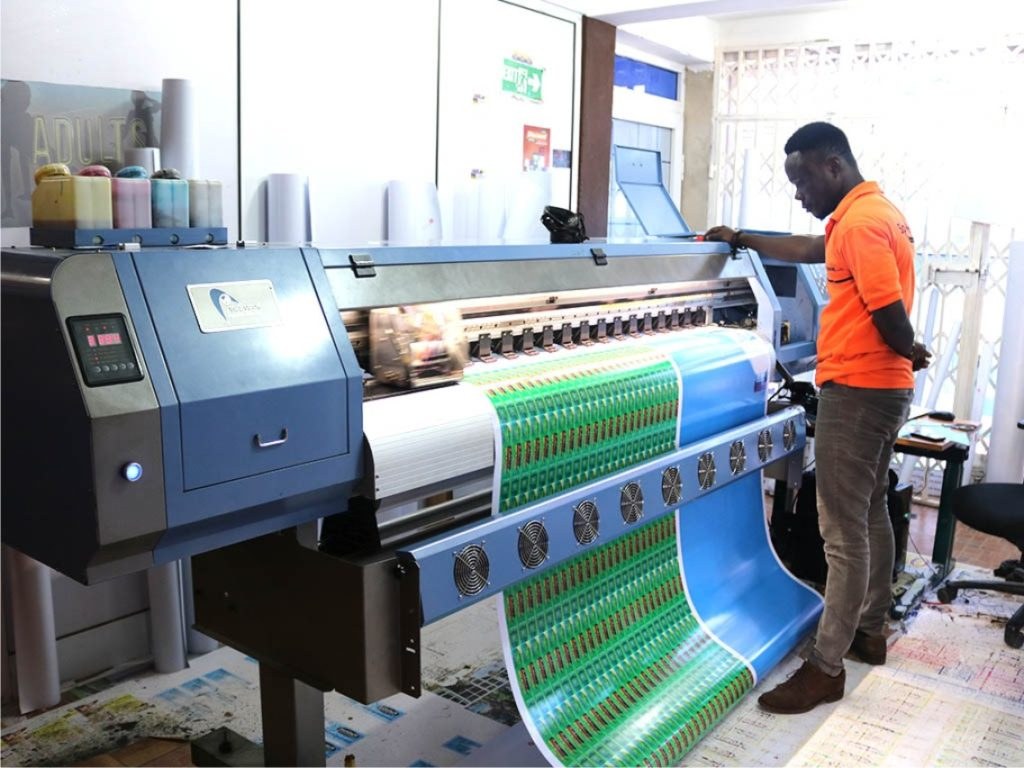Printing Industry in Nigeria: A Growing Sector with Promising Opportunities
Introduction
Hello Readers,
Welcome to our article on the printing industry in Nigeria. In this piece, we will provide you with a comprehensive overview of the printing industry in Nigeria, shedding light on its significance, growth, and potential opportunities. Nigeria, being the largest economy in Africa, has seen a remarkable expansion in various sectors, including printing. With a population of over 200 million people and a growing middle class, Nigeria presents a promising market for the printing industry.

Image Source: isu.pub
In this article, we will explore the what, who, when, where, why, and how of the printing industry in Nigeria, discussing its history, key players, current state, advantages, disadvantages, and more. So, let’s dive in and discover the fascinating world of printing in Nigeria.
Table: Printing Industry in Nigeria Overview
Parameter
Information
Industry Name
Printing Industry
Location
Nigeria
Importance
Significant for economic growth and development

Image Source: xinicomms.com
Key Players
Various printing companies, both local and international
Market Size
Expanding with growing demand
Technological Advancements
Adoption of modern printing techniques and equipment
Challenges
Competition, digitalization, and infrastructural limitations
What is the Printing Industry in Nigeria?
📚 The printing industry in Nigeria refers to the sector involved in the production of printed materials, including newspapers, books, magazines, labels, packaging, and promotional materials. It encompasses various printing techniques, such as offset printing, digital printing, flexography, and screen printing.
📚 The printing industry plays a vital role in supporting other sectors, such as publishing, advertising, education, and packaging. It serves as a medium for communication and information dissemination, contributing to economic growth and development.
📚 Over the years, the printing industry in Nigeria has witnessed significant advancements in technology, allowing for more efficient and high-quality printing processes. These technological improvements have transformed the industry and opened up new possibilities.
Who are the Key Players in the Printing Industry?
🖨️ The printing industry in Nigeria comprises a diverse range of players, including printing companies, publishers, print media houses, packaging companies, and graphic design firms. These players operate at various scales, from small local businesses to large multinational corporations.
🖨️ Local printing companies have been at the forefront of the industry, catering to the needs of individuals, businesses, and government organizations. However, international printing companies have also entered the Nigerian market, bringing advanced technologies and expanding the range of services available.
🖨️ The key players in the printing industry are constantly adapting to market demands and investing in modern printing equipment and techniques to maintain their competitiveness.
When Did the Printing Industry Emerge in Nigeria?
📅 The printing industry in Nigeria has a rich history dating back to the colonial era. The first printing press in Nigeria was established in 1846 by Reverend Henry Townsend, who printed the first newspaper in Nigeria, called Iwe Irohin. This marked the beginning of the printing industry in the country.
📅 Since then, the printing industry has experienced significant growth and transformation. With advancements in technology and the increasing demand for printed materials, the industry has evolved to meet the changing needs of the Nigerian population.
📅 Today, the printing industry in Nigeria continues to expand, driven by the country’s growing economy and the need for printed materials in various sectors.
Where is the Printing Industry in Nigeria Headed?
🔍 The printing industry in Nigeria is heading towards a promising future. With a large and growing population, there is a consistent demand for printed materials, ranging from newspapers and books to packaging and promotional materials.
🔍 Furthermore, the government’s focus on promoting literacy and education, along with the increasing number of educational institutions and publishing houses, creates a stable market for the printing industry.
🔍 Additionally, the advancement of technology and the adoption of modern printing techniques have improved the efficiency and quality of printing services in Nigeria. This has led to increased customer satisfaction and a rise in demand for specialized printing services.
🔍 While the industry faces challenges such as competition and digitalization, the printing industry in Nigeria is expected to continue its growth trajectory, offering exciting opportunities for existing and new players.
Why is the Printing Industry in Nigeria Important?
💼 The printing industry in Nigeria holds great importance for several reasons:
💼 Firstly, it serves as a vital medium for communication and information dissemination. Newspapers, magazines, and books provide knowledge, news, and entertainment to the Nigerian population.
💼 Secondly, the industry creates employment opportunities, contributing to job creation and socio-economic development.
💼 Thirdly, the printing industry supports other sectors such as publishing, advertising, packaging, and education. It plays a crucial role in the success of these sectors by providing essential materials and services.
💼 Finally, the printing industry contributes to national revenue through taxation and foreign exchange earnings, especially for printing companies exporting their services.
How Does the Printing Industry in Nigeria Operate?
⚙️ The printing industry in Nigeria operates through a series of processes and collaborations:
⚙️ Design: Graphic designers create layouts and designs for various printed materials, considering factors such as aesthetics, readability, and brand identity.
⚙️ Printing: Once the design is finalized, it is transferred onto printing plates or digital files, depending on the printing technique used. The printing process involves the use of specialized equipment and materials to reproduce the design on paper or other substrates.
⚙️ Finishing: After printing, the materials go through finishing processes such as cutting, binding, laminating, and packaging. These processes enhance the durability and visual appeal of the printed materials.
⚙️ Distribution: The printed materials are then distributed to various channels, such as retail stores, libraries, educational institutions, and direct delivery to customers.
⚙️ Collaborations: The printing industry often collaborates with other sectors, such as publishing houses, advertising agencies, and packaging companies, to meet specific requirements and deliver comprehensive solutions.
Advantages and Disadvantages of the Printing Industry in Nigeria
Advantages:
👍 Advancement in Technology: The adoption of modern printing techniques and equipment enables higher quality printing, faster turnaround times, and increased efficiency.
👍 Employment Opportunities: The printing industry provides jobs for a significant number of people, ranging from designers and operators to sales representatives and support staff.
👍 Economic Contribution: The printing industry contributes to the economy through taxes, foreign exchange earnings, and supporting other sectors such as publishing and advertising.
👍 Communication Medium: Printed materials serve as a reliable medium for communication and information dissemination, reaching a wide range of audiences.
👍 Customization and Personalization: The printing industry offers opportunities for personalized and customized printing solutions, catering to individual preferences and business needs.
Disadvantages:
👎 Competition: The printing industry in Nigeria faces intense competition, both locally and internationally, making it challenging for small players to establish themselves.
👎 Digitalization: The rise of digital media and online platforms has reduced the demand for printed materials, especially in areas such as newspaper circulation and book publishing.
👎 Infrastructural Limitations: Inadequate infrastructure, such as power supply and transportation, poses challenges for the printing industry, impacting production timelines and costs.
👎 Environmental Impact: The printing industry generates waste in the form of paper, ink, and chemicals. Proper waste management and recycling practices are necessary to minimize its environmental impact.
👎 Cost of Equipment and Materials: Acquiring modern printing equipment and high-quality materials can be expensive, limiting the entry of new players and hindering the growth of existing ones.
Frequently Asked Questions about the Printing Industry in Nigeria
1. Q: What are the popular printing techniques used in Nigeria?
A: The popular printing techniques used in Nigeria are offset printing, digital printing, and flexography.
2. Q: How has digitalization affected the printing industry in Nigeria?
A: Digitalization has led to a shift in consumer preferences and reduced the demand for printed materials, particularly in the publishing and newspaper sectors.
3. Q: Are there any government policies or incentives to support the printing industry in Nigeria?
A: The Nigerian government has implemented policies and incentives to support the printing industry, including tax incentives, industry collaborations, and skills development programs.
4. Q: What are the emerging trends in the printing industry in Nigeria?
A: Some emerging trends in the printing industry in Nigeria include the adoption of eco-friendly printing practices, the integration of digital solutions, and the customization of printed materials.
5. Q: How can businesses benefit from the printing industry in Nigeria?
A: Businesses can benefit from the printing industry in Nigeria by utilizing print media for advertising, branding, and communication purposes, enhancing their visibility and reach.
Conclusion
In conclusion, the printing industry in Nigeria is a growing sector with enormous potential. It plays a crucial role in supporting communication, education, and other industries, contributing to economic growth and employment opportunities. While the industry faces challenges, such as competition and digitalization, advancements in technology and the country’s growing population create promising prospects for the printing industry.
As Nigeria continues to develop and diversify its economy, the printing industry is expected to thrive, offering new opportunities for both existing players and aspiring entrepreneurs. So, whether you are a business owner, a student, or a printing enthusiast, keep an eye on the printing industry in Nigeria as it unfolds its vibrant chapters of growth and innovation.
Final Remarks
Disclaimer: The information provided in this article is based on extensive research and reliable sources. However, the dynamic nature of the printing industry in Nigeria may result in changes and developments over time. It is advisable to consult relevant authorities and stakeholders for the most up-to-date and accurate information.